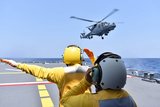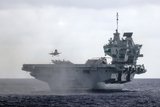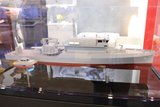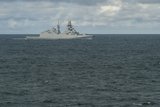IMDEX 2023: Unique challenges ahead for Singapore's new Navy chief
Singaporean stealth frigate RSS Intrepid pictured during an exercise with the USN. (Photo: US DoD)
The RSN is currently in the process of designing a new multi-role combat vessel (MRCV), offshore patrol vessel (OPV) and will upgrade its first Formidable-class frigates.
Wat was appointed Chief of Navy on March 10 2023, after his predecessor, Rear Admiral Aaron Beng, became Singapore's first naval officer to become the country's Chief of Defence.
'One challenge that confronts the RSN, and indeed Singapore as a whole, is the shrinking manpower resource.' Wat said in a written interview during IMDEX Asia 2023.
Related Articles
IMDEX 2023: Rafael offers ships laser air defence capability with Naval Iron Beam development
IMDEX 2023: Trio of naval programmes bolster Singaporean naval capabilities
IMDEX 2023: Saildrone ‘well equipped’ to support Asia-Pacific needs
'In building the Navy's capabilities for the future, we have looked at how we can design work processes to be more efficient so as to allow us to do more, with less. In the next bound, the RSN will leverage unmanned technology to continue to expand our operational envelope without levying a heavy manpower cost.' He added.
'While unmanned technology potentially unshackles us from the constraints imposed by declining birth rates, and allows us to undertake riskier operations without putting our sailors in danger, it cannot entirely replace core human functions that involve leadership, command, and complex decision-making.
'Therefore, the fleet of the future will likely be one of manned-unmanned pairing, which will allow us to reap the efficiencies of both manned and unmanned operations through proper integration and synergy.' He said.
Multi-role will be a design key element in RSN's future ships to tackle the evolving nature of conflict, factoring in the possibility of future requirements in multi-decade projects.
'By having multi-role as a key design philosophy, we are deliberate about building ships with operational flexibility to be able to take on missions that have not been envisaged yet, such as dealing with maritime security challenges that Singapore might face in the future.'
A critical project the RSN is undertaking is the MRCV program, touted to be a 'mothership' for uncrewed aerial and naval systems.
Saab and Odense Maritime Technology will provide the basic design, while ST Engineering will carry out detailed design and construction.
The first of six ships will be delivered from 2028.
The RSN is still designing OPVs to replace four ex-Fearless-class patrol vessels, now designated as Sentinel-class Maritime Security and Response Vessels.
Wat described that these would be purpose-built, designed with manoeuvrability to operate in congested waters around Singapore, and equipped with lethal and less-lethal capabilities for various maritime threats.
Also under study is the highly anticipated replacement for the Endurance-class LST, coined by the Defence Minister in 2014 as the Joint Multi-Mission Ship.
Wat said the Navy is still carefully examining the requirements, and the ship will be able to deploy uncrewed systems, incorporate sense-making and automation, and support large-scale multinational operations.
Finally, the RSN is finalising the details of the Formidable-class frigate update programme following detailed studies, and each mid-life upgrade will typically span between 2-3 years per ship.
Related Programmes in Defence Insight
Landing Ship Tank Replacement [Singapore]
Related Equipment in Defence Insight
More from IMDEX Asia 2023 Show News
-
![Philippine frigates progressively advance operational capability]()
Philippine frigates progressively advance operational capability
A couple of years into their service, the Philippine Navy continues to improve and test its two South Korean-built frigates.
-
![IMDEX 2023: MBDA and PGZ partnership includes ‘deep industrial cooperation’ on CAMM-ER]()
IMDEX 2023: MBDA and PGZ partnership includes ‘deep industrial cooperation’ on CAMM-ER
MBDA has confirmed that work with Poland on land and maritime air defence includes cooperation on the extended-range version of the Common Anti-Air Modular Missile (CAMM), known as CAMM-ER.
-
![Exclusive: Royal Navy Second Sea Lord on ships, the defence command paper, and the future Indo-Pacific presence]()
Exclusive: Royal Navy Second Sea Lord on ships, the defence command paper, and the future Indo-Pacific presence
The UK Royal Navy’s Second Sea Lord VAdm Martin Connell said it shouldn’t be a surprise that adjustments must be made ahead of a hotly anticipated new Defence Command Paper and praised the progress made by HMS Tamar and Spey in reinforcing the UK’s commitment to the Indo-Pacific.
-
Abeking & Rasmussen prepares to hand over Indonesian minehunters
Later this month, the German shipbuilder will deliver two minehunters to the Indonesian Navy.
-
![IMDEX 2023: Fincantieri seeks to satisfy conditions for Indonesian FREMM frigate deal]()
IMDEX 2023: Fincantieri seeks to satisfy conditions for Indonesian FREMM frigate deal
Italian shipbuilder Fincantieri is continuing to work with Indonesia to satisfy the conditions for a FREMM frigate contract to enter into effect.
-
IMDEX 2023: Flyby and Thales look to further Jackal development after successful missile firing
Having successfully developed and successfully fired a Lightweight Multi-Role Missile (LMM) from the Jackal drone, Flyby Technology and Thales see the system as offering a cross-domain capability for the UK and others.























